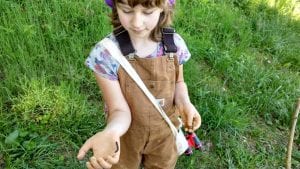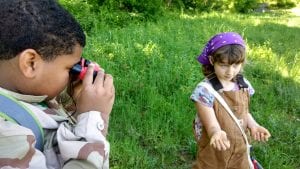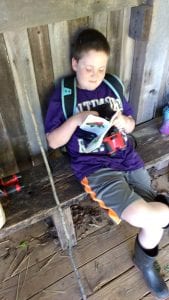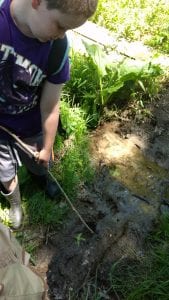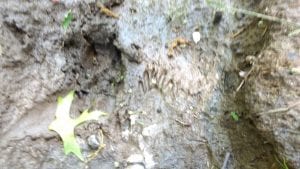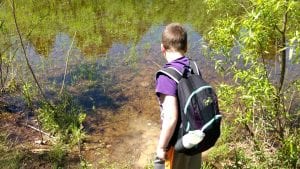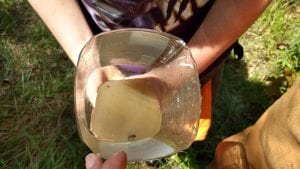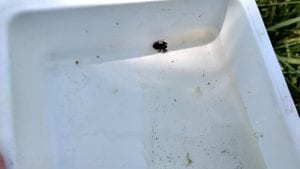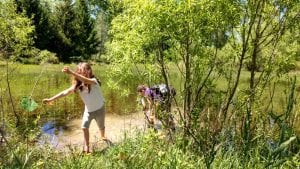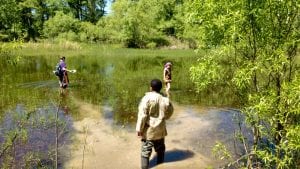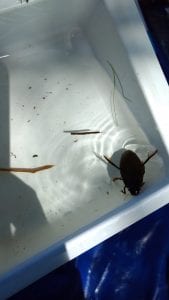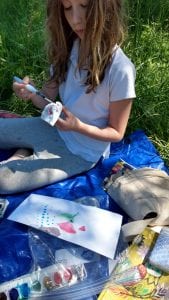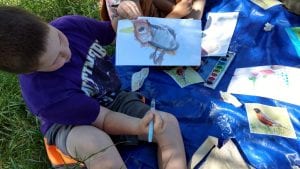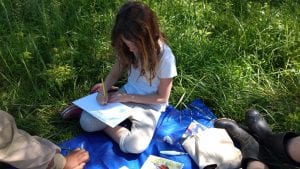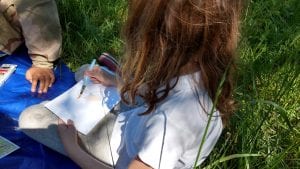Monday:
Today we welcomed a new homeschooler to Living Wetlands, welcome Audrey! We were so glad that Audrey was able to join us for our last few days of class and we hope she made some great memories (and learned a thing or too, also). Today was all about the birds. We got a real treat as Colby stopped by briefly on his way to the other homeschool group with the barred owl, perfect timing! It was a great opportunity to get a close up look at another one of our bird ambassadors to Irvine (we met the American kestrel before). The barred owl is such a different bird with very large, sharp talons and striking black eyes and streaking on her feathers, which helps her blend in with the trees in the forest. After our bird encounter we headed to our meeting circle. We greeted Audrey to our group and went over the plan for the day. After passing out binoculars we headed out onto the trail, but we didn’t make it far because we found our first bird, a White-breasted Nuthatch. It was also a good time to practice using our binoculars and we took that moment to also learn why it’s important to study birds and be able to identify them by sound. Most birds you won’t even see in the forest but you will definitely hear them. After spending about 60 seconds in silence we each counted somewhere between 5-10 different birds! We didn’t know what they all were but it was a great opportunity to listen to the chorus of the forest. We started our bird count. The bird species we saw and were able to identify were white-breasted nuthatch, American robin, eastern bluebird, tree swallow, gray catbird, house wren, northern cardinal, red-winged blackbird and bluejay.
Heading into the meadow, Victoria showed us a tent caterpillar and shared her knowledge about how they are insects and their legs not all being legs (because insects have 6 legs but caterpillars appear to have more. In fact, they do have only 6 legs and the rest are called prolegs). We hiked down to the Ed Hut where we got out our bird guides and searched for the bird that we saw swooping over the meadow. I asked everyone what colors they noticed and where those colors were and they said they saw white and it was on the belly. I asked them next if the bird was bigger or smaller than a robin and it was smaller. Solace flipped right to the bird and everyone else found it right after, it’s a tree swallow! We also watched the eastern bluebirds go in and out of the bluebird box frequently, there might be babies they’re feeding! (We looked them up in the bird guide next, this time since we knew the name of the bird we practiced using the Index). It was a really nice day so it was time to begin our hike to the vernal pond. We went a slightly different route through the meadow but it was a lot faster once we found the right trail and before we knew it we were at the stream we had snack at a few weeks before. This time, Charlie found deer tracks and also a raccoon track and knew exactly what each of them were right away, nice spot Charlie!
At the pond we laid down a tarp at the pond in the shade and enjoyed pond exploration and painting. We all made a few observations first about the pond and we noticed that the water was a bit lower and there was more grass growing up out of the water. We also had to be careful with how we walked in the water because a lot of the tadpoles have gone through metamorphosis and are now froglets! We spent the rest of class either exploring the pond or painting on the tarp. We were painting birds, either just the bird or birds in an environment. An American robin bird served as our inspiration. Charlie and Victoria spent most of the time in the pond and found a HUGE diving beetle, wow! Check it out below in the picture above. Diving beetles are voracious pond predators and feed on smaller insects and other animals in the pond. They breathe oxygen from the air, not with gills, and they do this by storing air bubbles under their belly (that’s why their belly looks shiny). You will often see a water bubble on the very back end of their body too, this is where they breathe the oxygen. They use feathered legs for swimming and have fantastic eyesight, you can even see their large eyes.
Tuesday:
Yesterday was such a great day learning about birds, today was plant day! We started in the place we began studying our own plants at the story circle, where we looked at the changes our plants were going through. Our phenology study really gave us a new perspective on how plants change and helped us hone our naturalist observation skills. It was time to use a dichotomous key (we used one of these for the aquatic insects at the pond a few weeks back!) to identify the tree I’ve been doing my phenology study on (I actually wasn’t sure what tree it was and I’m not 100% we got it right but it was a great experiment). Here we are working on IDing the tree (we had to get a closer look and touching it was important too!).
The first question we had to ask was whether the tree has needles or leaves. Our tree has leaves so that took us past the trees with needles. Next we had to ask if the leaves or buds (leaves in this case) grow opposite each other or alternatively. Opposite means they are directly across from each other on the stem, which our tree is! Okay, next question…are the leaves compound and composed of several leaflets or are they simple. A simple leaf would be a maple leaf however the tree we are looking at has compound leafs. You can see where each leaf starts just below my hand where the tree goes from wood to green stem. The stem Charlie is touching is all one leaf and all the green leafs you see are actually leaflets. So that took us to the next question, do the leaflets radiate from one point (like a pan or hand) or not. In this case they do not. Now we are on the page you can see in the picture above that has Ash trees. I think we’re on the right track! Next question…are the leaflets roughly all the same size and shape or are they different sizes. Our tree is mostly the same so onto the next question. Do the leaflets have a short stem or no stem. This means that the bottom of each leaflet is pretty much touching the stem that Charlie is touching. In this case our tree does have a small stem for each leaflet, even though it looks like they’re almost touching but there is a small stem. Next, are the leaflets regularly toothed (which means they have ridges along the edge of the leaf) or are they not regularly toothed. Our tree isn’t so we move on to the next question in our quest to identify this tree. Are the twigs and leaf stalks hairy or not hairy (this is why touch is important!) and in this case, not hairy, so onto the LAST question. Are the leaflets whitish beneath or green on both sides. Green on both sides so we have Green Ash (Fraxinus pennsylvanica subintegerrima).
After a plant clue game we walked down the trail a bit and did a journaling activity. Everyone picked a plant even if they weren’t sure the name of the plant and then drew a picture and made three observations, “I notice…”, “I wonder…”, “It reminds me of…” and everyone named their plant with their own made-up name (we’re all getting started in the picture above). Charlie, Solace and Audrey all picked May Apple but they didn’t know what it was at first and not knowing can help you see the plant in a new way. Solace said it reminded him of a sea star. Victoria chose an unknown plant, which we thought may have been some sort of violet. At the gazebo we ate snack and read the first part of a story book about Lupins called Mrs. Rumphius. Since it was plant day we wanted to check out the cattails and see how much they have grown. On the way, we walked along the boardwalk and stopped at the fallen log for some leaf pressings in quick dry clay. It took a bit of trial and error but eventually everyone got pretty cool looking imprints. We also had a bit of leftover clay to make our own creations. On our way to the cattails Solace found a green frog near the creek! It is always exciting to find a frog and this time we got to all get a close up look at it. It wasn’t full grown but it was starting to show its green frog features, such as the ear drums and the two parallel ridges down the back. We also found a crayfish in the creek. We ventured into the cattails which have really grown a lot and pulled a few out and got a closer look. We all smelled the shoot and agreed it smelled pretty good and smells like cucumber or apples. They are edible but need to be thoroughly cleaned and there is a specific way to eat them as well and usually they are better consumed during certain times during their growing period. If you want to learn more here is a lot of great information http://www.eattheweeds.com/cattails-a-survival-dinner/comment-page-1/
As always, please do ample research and be very confident in your foraging skills before eating anything from nature. Next week is our last week of the Spring semester of Living Wetlands.
- Victoria with the tent caterpillar
- Identifying the birds in our bird guide
- Charlie found tracks!
- Blurry photo of the raccoon print
- At the pond
- Here is one of the froglets
- They’re so small!
- Pond exploration
- The water beetle
- Water color painting
- Painting robins and other birds




